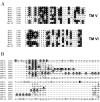In silico identification and expression of SLC30 family genes: an expressed sequence tag data mining strategy for the characterization of zinc transporters' tissue expression
- PMID: 15154973
- PMCID: PMC428573
- DOI: 10.1186/1471-2164-5-32
In silico identification and expression of SLC30 family genes: an expressed sequence tag data mining strategy for the characterization of zinc transporters' tissue expression
Abstract
Background: Intracellular zinc concentration and localization are strictly regulated by two main protein components, metallothioneins and membrane transporters. In mammalian cells, two membrane transporters family are involved in intracellular zinc homeostasis: the uptake transporters called SLC39 or Zip family and the efflux transporters called SLC30 or ZnT family. ZnT proteins are members of the cation diffusion facilitator (CDF) family of metal ion transporters.
Results: From genomic databanks analysis, we identified the full-length sequences of two novel SLC30 genes, SLC30A8 and SLC30A10, extending the SLC30 family to ten members. We used an expressed sequence tag (EST) data mining strategy to determine the pattern of ZnT genes expression in tissues. In silico results obtained for already studied ZnT sequences were compared to experimental data, previously published. We determined an overall good correlation with expression pattern obtained by RT-PCR or immunomethods, particularly for highly tissue specific genes.
Conclusion: The method presented herein provides a useful tool to complete gene families from sequencing programs and to produce preliminary expression data to select the proper biological samples for laboratory experimentation.
Figures




References
-
- Chimienti F, Aouffen M, Favier A, Seve M. Zinc homeostasis-regulating proteins: new drug targets for triggering cell fate. Curr Drug Targets. 2003;4:323–338. - PubMed
Publication types
MeSH terms
Substances
Associated data
- Actions
- Actions
- Actions
- Actions
- Actions
- Actions
- Actions
- Actions
- Actions
- Actions
- Actions
- Actions
- Actions
- Actions
- Actions
- Actions
- Actions
LinkOut - more resources
Full Text Sources
Other Literature Sources
Molecular Biology Databases
Research Materials

